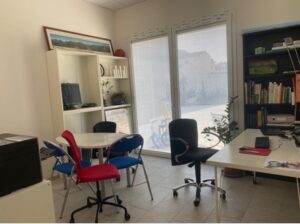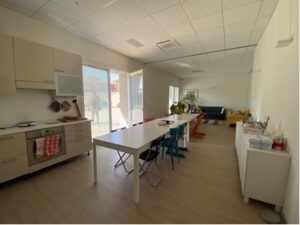| This article is part of a series and has been written by the Master’s students in Global Politics and Society, led by Professor Franca Maino, at the University of Milan. As attending students of “The Welfare States and Innovation” course, they explored the connection between Social Innovation and new forms of Welfare in contemporary societies. The aim of the articles is to highlight the development of new synergistic partnerships among actors involved in multi-stakeholder networks and innovative multi-level governance models for social policies. |
Co-housing as a social innovation
If you are moving today to a bigger city, you might be familiar with the difficulty of finding appropriate housing; it is scarcely available and often quite expensive. But not only that: when you finally find an apartment, it might be hard to get in contact with people because everyone lives in “their own room” as an individual – even more so during the pandemic. Also, if you are older or have kids, you might need regular help from other people to watch your children for a bit or assist you in buying groceries. Or you might simply want to share your life with others with countless opportunities. To solve these myriads of problems, we could start tackling some of them with different long-known policy measures, or we could look for innovations, i.e., newly created tools or means for social change. In short, co-housing could be a new idea to live together – to organize shared living spaces.
The tradition of experimenting with new forms of collective and shared living spaces finds its roots in the ‘60 and ‘70, mainly in the North European countries (Lietaert, 2007). However, Europe is currently witnessing a new wave of collective self-organized forms of housing provision. We can understand co-housing as “small-scale resident-led housing with common spaces and shared facilities, located either in cities or in rural areas, intended to foster values such as environmental sustainability, solidarity, participation, mutual cooperation, and sharing of resources, knowledge, and expertise among members of the community” (Bettini, 2017: 2). This idea of creating living spaces for people to live together in various forms can tackle most of the issues raised earlier.
To understand such projects in more detail, we interviewed two projects, one in Milan (“Base Gaia”), where families decided to share their daily lives, and the other one in Lyon (“Chez Moi Demain”), a project promoted by a company that helps to realize co-housing projects. Apart from different legislative backgrounds in Italy and France, where the latter indeed has the more encompassing and favouring guidelines, we wanted to know how the two projects differ regarding their foundation, day-to-day governance, and the impact of the COVID-19 pandemic.
The Italian Case – Base Gaia
Base Gaia is a co-housing project consisting of 10 households located in Milan, very close to the western part of the Lambro Park. The land on which the building was later constructed was chosen in 2014 by four founding families to be then inhabited in late 2019 or early 2020. Each family has its own flat and shares an outdoor area, a room dedicated to GAS products, a shared laundry room, and a terrace. The 200 square meters on the ground floor are communal spaces (a multi-purpose hall, a communal kitchen, a one-room apartment for guest use, and a children’s room). This group of families is also a small social community open to the territory. It is available to host citizens, associations, groups for events, exhibitions, conferences, parties, courses, and anything else that can be developed within their shared spaces.
The French Case – Chez Moi Demain
The French case is “Chez Moi Demain,” which is based in Toulouse and is a company specializing in the construction and management of supportive, ecological, multi-generational, and convivial living spaces. Therefore, they are responsible for more than one co-housing project. They are currently run by three partners who assist people with co-living plans in this complex and time-consuming endeavour. While they are still a young company, they have finished over six projects. For example, they managed a project mixing participative housing, inclusive housing, shared spaces, and services in Villefranche.
The foundational process
Concerning the foundation of the two projects, we focused on their original intent, values, and the actors involved. The Basa Gaia project started ten years ago as an idea of 4 families from the same social cooperation environment. For them, the intent was to spend the rest of their lives in a context that was not the classic condominium but in a network of personal relationships where they could cultivate mutual help. On the other hand, the Chez Moi Demain project was realized four years ago by two partners from the world of digital communication who decided to capitalize on their know-how in projects with a social impact.

Thus, while in the Italian case, we find the families at the center of the project, in the French case, we find project managers who assist different owners in creating their co-housing space, e.g., different smaller groups wanting to share living space. Concerning values, the Italian project is not based on political or religious beliefs but shared collaborative principles. The French project shows a coordinating attitude since it is focused on managing its clients’ diverse values.

In both projects, there is a common root: the innovative vision toward the possibility of realizing and conceptualizing a new meaning in inhabiting a space, both from the point of view of actually living that space and from the point of working to create it.
The impact of governance
Considering the governance aspect, a company such as Chez Moi Demain can be very helpful in understanding how a co-housing project works. As the process is generally very complicated, they take care of the project management providing legal and financial support and working on regulations through a whole technical team. They take care of all the necessary steps “making the project concretely, from who draws it up to the craftsmen who intervene on the building site”. Talking about state subsidies in this field, they said that “in the future, these projects will be more and more subsidized because there are more and more governmental actions that bring aid to retirement homes towards the creation of inclusive habitats that aim at integration”.
On the other hand, Base Gaia came out with a bottom-up approach without any help or coaching. Residents are divided into several internal committees: one committee deals with the construction company, another one deals with public relations, the third one with expenses, and so on. Talking about the relationship with the local government, they affirmed that “the only real thing was in the penultimate Territorial Government Plan (of Milan, Ed.), where co-housing has been included as a form of social housing. So, we entered this category with all the advantages, the reductions, and the obligation to follow certain rules of social housing (such as the presence of people with a certain type of income and the fact that the house is not sellable on the market price for 30 years)”.
This step gave them discounts in terms of urbanization charges and bonuses. However, they stated that “we need a specific regulation for co-housing (as it has been doing in France, Ed.) because, since the classic condominium provide that shared space is limited, from a minimum of 1% to a maximum of 10%, we had to make a giant bathroom in the studio apartment (for guests); if we had used those last five square meters as shared spaces we would have overflowed from the regulation”.
Finally, it is clear how the governance aspect of co-housing projects is undoubtedly more structured on the French side, considering the legislation’s evolution. In Italy, the first steps are starting to be taken, such as the flanking of social housing. However, in general, there is still scarce attention to creating a specific regulation with new parameters in line with the social character of these projects.
The effects of the COVID-19 pandemic
Covid-19 substantially impacted most areas of life; housing became a new and intense center of day-to-day life. Many shared spaces were closed due to hygiene and health requirements. Interpersonal relations and community building became increasingly tricky as social distancing rules created social exclusion. However, we learned during the interviews how co-housing could counter some adverse social effects of the pandemic. Especially regular communication and vivid brainstorming for solutions helped many residents handle the situation. As one person in the Italian project mentioned: “The good thing was that being here together, we helped each other a lot and had our own internal hygienic rules, and mutual trust was crucial. However, we didn’t give up socializing and helping each other because the children were always in shared areas and couldn’t go to school”.
Generally, the pandemic had been an accelerator for co-housing projects as people noticed that living alone was not the best solution. The mutual aid, discussions, and activities helped several persons to bear some hardship that originated from the lockdowns. The French interviewee remarked: “The COVID-19 pandemic has been a great accelerator. People no longer want to live alone, locked up between four walls, no links, no group intelligence: I have examples of projects where no one knew each other, and all the co-housing inhabitants passed the lockdowns very easily”.
While experiences in different countries might have been diverse, we can find a common denominator. Living together in co-housing projects created supportive networks that helped people through the crisis. This underlines the need for more comprehensive co-housing projects which can autonomously help people through times of hardship and create reliable social networks. While it is ultimately up to the individuals to decide on their living situations, governmental incentives can support such more sustainable living arrangements, including less affluent people.
We would like to thank the people of Base Gaia and Chez Moi Demain who have made our research possible.
References
- Bettini, F. (2017), Inclusivity in cohousing: A Comparative Legal Analysis of Sustainability and Enforceability, in “IASC 2017”, Sciences Po Law School, pp. 1-33.
- Bresson, S., Labit, A. (2019), How Does Collaborative Housing Address the Issue of Social Inclusion? A French Perspective, in “Housing, Theory and Society”, vol. 37, pp. 118-138.
- Corubolo, M. (2021), Product service system design for collaborative housing and their communities. The case of an Italian coliving project, in “Design Culture Symposium 2021: Product-Service System. Research Publications POLIMI”, pp. 7-17.
- Lang, R., Carriou, C., Czischke, D. (2018), Collaborative Housing Research (1990–2017): A Systematic Review and Thematic Analysis of the Field, in “Housing, Theory and Society”, vol. 37, pp. 10-39.
- Lietaert, M. (2007), Cohousing e condomini solidali. Guida pratica alle nuove forme di vicinato e vita in comune, Editrice Aam Terra Nuova, Firenze, Italy.